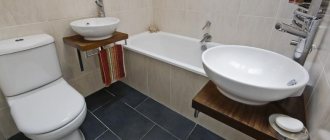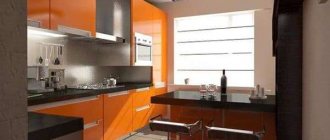Repair
0
14 891
Share
In old houses built under Stalin, the bathroom was often combined with the kitchen. Moreover, several families could live in a communal apartment. While one family prepared food, another could shower behind the curtain. Today it seems strange and inconvenient.
- Layout options in old houses
- Kitchen bath designs
- The practical side of repair
- What to do if the bathroom is out of place
Move and expand the kitchen at the expense of the living space
According to current regulations, the kitchen and bathroom (the so-called wet areas) are prohibited from being located above living spaces in an apartment building. That is, if your apartment is located on the ground floor or above non-residential premises, then you can move the kitchen to the living room.
The second option: in a combined kitchen-living room, leave the stove and sink in the non-residential area of the kitchen, and move the furniture and refrigerator into the room - visually the kitchen will expand, but technically will remain in its place.
Redevelopment of an apartment with one bathroom
If the housing is equipped with one bathroom with a toilet, redevelopment in which access will be made to living rooms and kitchens is prohibited.
If the housing is equipped with one bathroom with a toilet, redevelopment in which access will be made to living rooms and kitchens is prohibited.
In projects involving the expansion of a bathroom into the area of a non-residential premises or its relocation, exits should be correctly placed taking into account Sanitary Regulations and Regulations.
Move and enlarge the kitchen at the expense of non-residential areas
You cannot swap the kitchen and bathroom, expand the kitchen at the expense of the bathroom, or make the entrance to the only bathroom from the kitchen. It is also prohibited to arrange the only entrance to the gasified kitchen from the room.
It is allowed to connect a corridor, hallway or storage room to the kitchen. If the kitchen is not gasified, you can even move it completely into the hallway - this layout is called a niche kitchen. The freed-up kitchen area can be used as a room, but in the plan it is better to call it a non-residential space, for example a dressing room or pantry.
Placing a kitchen on the territory of a bathroom, as well as vice versa, is prohibited, because technically you are worsening your conditions. Such redevelopment may be approved if you provide a notarized consent to the voluntary deterioration of your living conditions with the obligation to inform buyers about this when selling the apartment. The same applies to expanding the room through the kitchen.
How and where you can move the kitchen, bathroom and toilet
Despite the fact that in 2011 the above-mentioned resolution of the Moscow Government No. 508 came into force, which, in general, simplified the procedure for approving redevelopment, the rules for relocating a kitchen, bathroom and toilet are still very strict. The kitchen, bathroom and toilet should not be located above the room - the place where people actually live.
What are the ways out of this situation?
- Firstly
, you can buy an apartment on the ground floor.
Then no one will definitely live under you, and you can move the kitchen into the restroom, the restroom into the room, and you yourself will begin to live in the former kitchen (well, or a more realistic and necessary option - increase the area of the kitchen, bathroom or toilet at the expense of the living space )
. - Secondly
, on the contrary, you can buy an apartment on the top floor.
This method will allow you to expand the kitchen using the area of the bathroom and toilet. It's funny that they don't allow this on other floors, because in this way you seem to worsen your own living conditions - your kitchen ends up under someone else's bathroom. And if you live on the top floor, then no one will wash above your kitchen (well, except in the rain on the roof)
, so expand it to your heart’s content. - Third
, if you do not live on the first or last floor, you can negotiate with your neighbor below and ask him, say, to organize an office under your kitchen. The office does not fit the description of the room; people do not live in it permanently, so the kitchen, bathroom and toilet may well be located above it. On the other hand, why do you need such a crazy neighbor who will agree to this?
And one more detail - the exit from the toilet should not lead into the room or kitchen. Of course, it is also possible to get around this rule - you just need to have access from the bedroom to a combined bathroom, and the apartment should have another toilet with access to the corridor.
Well, no one said that redevelopment is easy!
Move the sink, stove and utilities
It is not allowed to take the sink outside the wet area. You can move a sink along a wall without any approval at all, but other moves—for example, to an island—will require a project. If a heating radiator interferes with the installation of a sink near a window, it can be moved with the permission of the management company.
A gas stove may only be moved with an approved redevelopment project. At the same time, it is forbidden to install the stove against a wall made of flammable materials, use flexible hoses longer than 1.5 meters and touch the main gas risers.
It is prohibited to make grooves for laying pipes and wires in load-bearing walls, as there is a risk of damaging the fittings. Do not put gas pipes into boxes and block access to taps and valves.
Exit from the bathroom to the living room after remodeling
Building codes and regulations that are mandatory for the construction of new housing state that the exit from the bathroom or restroom cannot be directly into the living space. This is how all apartment buildings are built. Even in modern building designs, many of which are rented even without internal partitions, they are required to have a designated non-residential area at the exit from the bathroom.
Many houses have recently been sold in violation of the basic rules for placement and designation of the bathroom area, and this point requires special attention when purchasing residential real estate.
It is also easy to unknowingly violate existing standards during illegal redevelopment and subsequently incur costs for restoration repairs.
Combine the kitchen with a balcony and loggia
Attaching the loggia to the kitchen is possible if you do not touch the load-bearing walls, leave in place the window sill block that holds the stove, and mark in the plan a partition between the loggia and the kitchen. Often the window and door are removed, and the window sill block is disguised as a table or counter. If the block does not have a load-bearing function, it can be removed and folding glass or sliding doors can be used as a partition. The attached loggia will have to be insulated. Heating batteries cannot be moved from the apartment to the loggia.
Kitchen and bathroom design
If you have installed partitions and the kitchen is visually smaller, you can compensate for this with light walls and pastel shades of kitchen furniture. Additionally, hang mirror elements on the walls and ceiling that will expand the space.
Folding tables and chairs will help you save extra meters, which every housewife needs when cooking. Instead of a separate table, you can put a bar counter and bar stools. In the bathroom, you can save space by removing the sink and floor cabinets.
Lawyer's answers to private questions
Is it possible to do redevelopment in a municipal apartment?
The law does not directly prohibit it. But before starting work, you need to obtain written permission from the Department of Housing Policy - the owner of the municipal apartment. If redevelopment is allowed, it can be done. In case of failure, unfortunately, repair work is prohibited.
Is it possible to expand the room through the corridor?
Yes. To do this, you can move a non-load-bearing wall in the apartment between the room and the corridor. Due to this, part of the non-residential space will become residential. The main thing is not to forget about the exit from the combined bathroom - the door should be in the corridor, and not in the living room. There is also an option to expand the living room by removing the built-in wardrobes.
Is it necessary to coordinate the expansion of the doorway in the kitchen? We plan to make it 10 cm wider.
Depends on the purpose of the wall. If it is load-bearing, any openings must be agreed upon with the author of the house. And strengthen the opening with metal structures around the entire perimeter. If the wall is not load-bearing, then a 10 cm opening is too minor a change. They can be coordinated according to the sketch, and not according to the project. Often inspectors do not have questions about minor deviations from the technical plan.
Expansion of the bathroom through the corridor
When a large corridor adjoins the bathroom, it is allowed to expand the wet area at its expense. Corridors are the non-residential part of the apartment, and it is allowed to organize wet areas in them. When part of the corridor extends into a wet area, it is necessary to provide for the possibility of normal passage in the corridor. The minimum comfortable width of a corridor for passage is 90 centimeters, and the average width of corridors in standard-produced houses is 110–150 cm; accordingly, enlarging the bathroom by 30–50 centimeters will make it more comfortable and allow you to use the corridor without any problems.
Moving the bathroom to another wall - how to coordinate
If all the work carried out in the apartment is limited to cosmetic repairs and is supplemented only by the renovation of the bathroom with a change in the position of the bathtub (without moving), then this option involves the possibility of coordination according to the sketch.
It is important to remember that the installation device, the installation of a decorative box and the creation of various structures change the parameters of the room, which must be reflected in the redevelopment project.
Remodeling the bathroom makes it possible to install modern plumbing and make your home much more comfortable.
To prepare the design and technical documentation necessary to approve the redevelopment, you must contact an organization that has the necessary SRO approval, which today is analogous to a license.
Our organization has been preparing redevelopment projects and technical reports for many years. In addition, it is possible to delegate the entire approval procedure, up to the receipt of the final BTI documents, to our specialists.
You can view various redevelopment projects that have already been agreed upon and implemented in practice here. You can consult and ask questions about redevelopment to our specialists in writing on the website or by email, as well as by phone.
Moving and organizing a bathroom in the hallway
It is possible to locate wet areas above the non-residential part of the apartment from below, but provided that high-quality waterproofing is done and there is a possibility of connecting to utility networks. It is worth considering that this is a technically complex and expensive redevelopment, and it can only be carried out after a positive decision from the housing inspection. To move a bathroom into a former corridor, you will need the help of highly qualified specialists, whose services cannot be called budgetary - you won’t be able to save money.
In what cases can a kitchen move be carried out?
Let’s make a reservation right away that moving a kitchen without approval is strictly prohibited and is considered an illegal action, entailing corresponding consequences.
There are 3 cases in which you can consider moving a kitchen, each of them has its own advantages and limitations:
- If the apartment is on the 1st floor and there is a basement below it, or if the floor below is a non-residential premises.
- If the apartment is on the middle floor, and there are residential apartments below and above it.
- If the apartment is on the top floor.
We'll look at each in more detail in the following sections of this article. But let us immediately note an important point: for all 3 cases, a single rule applies: obtaining permission to move the kitchen is possible only when using an electric stove; if a gas stove is used, then moving the kitchen is strictly prohibited. However, there are some nuances here too, we’ll talk about them later.
It is legally possible to carry out a kitchen relocation if a number of conditions are met. At the same time, it is not possible to move the kitchen into all rooms; prohibited areas include:
- Bathroom or toilet (applies to all floors except the last). The inability to agree on the transfer of the kitchen in the apartment to the bathroom or, for example, to the toilet lies in the deterioration of the living conditions and associated problems with further sale, since your kitchen will be located in a high-income zone.
- Balcony (loggia). Moving the kitchen to a balcony or loggia is also prohibited by the Housing Code in most houses built in the 70s-90s, since these liberties contradict sanitary and construction standards; therefore, with such a transfer of the kitchen, it is impossible to obtain approval from the BTI and the Moscow Housing Inspectorate.
- Living room (if there is a living space on the floor below). Moving a kitchen into a room is illegal, as follows from the provisions of Decree of the Government of the Russian Federation No. 47 of January 26, 2006, which prohibits placing a kitchen above the living quarters (rooms) of neighbors below.
If the last condition is violated, the owner faces a fine for moving the kitchen into the living room. If any of the neighbors or employees of the management company write a complaint against you, the consequence will be an inspection. Although the fine, according to the current legislation, is small - only 2,500 rubles, however, based on the order, a requirement will be imposed to return the old layout of the apartment to its original position, and this is wasted time and money, which will also be spent on repairs in connection with the return of the kitchen to previous place.
Next, we will take a closer look at the nuances of such redevelopment in each of the 3 cases mentioned above.
Write to us on WhatsApp
Get expert advice or send us the necessary documents for a preliminary assessment.










